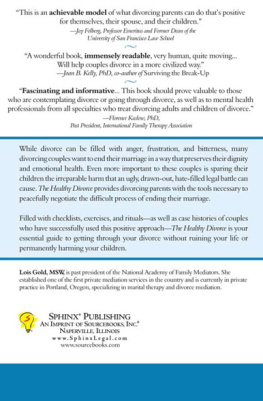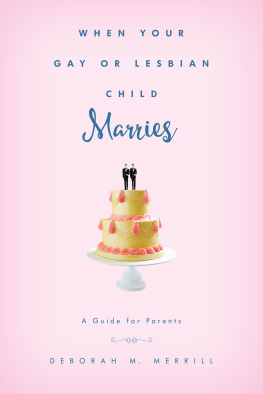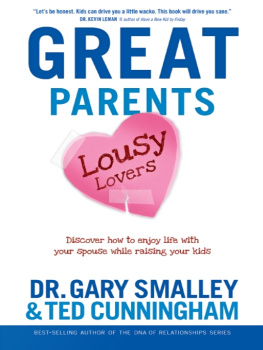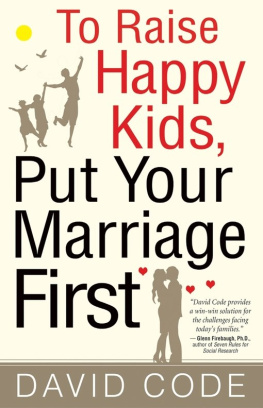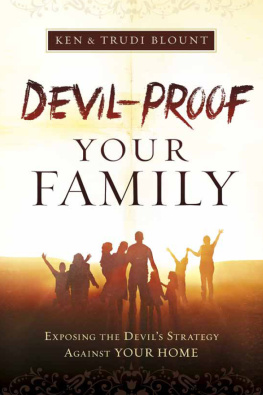Contents
Introduction:
Your MarriageYour Childs Blueprint for Intimacy
1 How Children Learn from the Marriage
I Wonder What You Will RememberWhen You Are Grown Up
2 Establishing the Priority of the Marriage
Dad and I Are the Most Important Peoplein Each Others Lives
3 Teaching the Value of Interdependence
Mom and I Are Always There for Each Other
4 Instilling the Importance of Mutual Respect
Marrying Your Mom/Dad Wasthe Best Thing I Ever Did
5 Maintaining Trust in Word and Deed
Partners in a Marriage Try Not to Let Each Other Down
6 Negotiating Differences Constructively
Sometimes We Disagree, but We Always Stickwith It and Work It Out
7 Understanding the Long-Term Effects of Conflict
Ill Never Forget the Looks onTheir Faces When We Fought
8 Emphasizing the Positives
Laughing Together and EnjoyingEach Other Are Part of Who We Are
9 Building a Better Marriage
It Is Never Too Late to Try
T WO YEARS AGO a colleague asked me if I would be interested in participating in a community event for parents. The colloquium would consist of a group of local pediatricians, child psychologists, educators, and other experts who would address the topic What Children Need in the Twenty-first Century. I was asked to speak about the changes we could anticipate in the home, and, specifically, what children would need from their parents marriage.
At first I was somewhat taken aback. For the previous fifteen years my practice, speaking engagements, and publications had been almost exclusively devoted to couples therapy, and in subtle but significant ways I had shifted my perspective away from children. This was a shocking realization, for I was also the mother of two young children and struggling with all the changes that had taken place in my own home after they were born. How odd that I, who had worked with families of troubled children for over ten years, had lost touch with this focus. Of course the parents marriage affected the children. Of course I could speak on that subject at the community lecture.
That night, several parents stopped to talk to me after my presentation. Their interest and heartfelt thanks were very gratifying. But something else happened two weeks later that had an even greater impact on me. Peter and Catherine called for an appointment and said that they had decided to get help with their marriage after hearing me speak. They brought their beautiful eight-month-old daughter, Amy, with them. After they introduced Amy to me, Catherine said, It took us five years of clinics and infertility treatments to get Amy. Im forty-four now, and Amy is our only child. Peter and I want her to be happy, but we fight all the time. Even now she looks at us when we start to shout, and if we keep at it, she starts to cry. Help us for her sake.
I will say more about Peter, Catherine, and Amy later in this book. In fact, the book is filled with families I have known and treated for the past twenty-five years. My first professional job was as a social worker in Torontos Hospital for Sick Children, where I worked with families whose children had physical symptoms that did not have a medical cause. In this capacity I worked with several hundred parents, all of whom dearly loved their children but who had no idea that the tensions and problems in their marriages were having such a devastating impact on their offspring. This was my first exposure to the extent to which children react to issues that parents incorrectly assume are private, or are beyond a childs awareness. My years of experience with these families helped me realize the power of the marriage in shaping the personalities and well-being of the children. In fact, I grew increasingly interested in marriages, and chose to pursue this area in my doctoral studies.
Although my interest in marriage therapy was originally based on my respect for the importance of the marriage in building a healthy environment for children, I discovered yet another amazing fact: Even though the adults I worked with did not report unhappy family lives or symptomatic childhoods, the problems that interfered with their happiness were also invariably linked to their own parents marriages.
In helping couples make sense of their expectations and reactions to each other, I quickly realized the extent to which the marriage the child grows up with influences his own future relationships. Almost all the adults I have counseled in marriage therapy have been profoundly affected by their own parents relationships. Beliefs about intimacy learned in childhood had led to fears, defensive postures, and expectations that worked against intimacy. Even marital partners seemed unconsciously chosen so that aspects of the parents marriage would be re-created.
I was rather surprised to discover that what to me seemed so obvious was rarely mentioned in the professional literature. Therapists working with individuals emphasized the extent to which children are affected by the relationships they have with each individual parent, but totally neglected the importance of the relationship between the parents. Family therapists focused on the problems that can arise in children when the parents marriage is conflicted or problematic, but neglected the extent to which the relationship that was observed in childhood profoundly influenced intimacy in the grown child.
The purpose of this book is to create a greater awareness of this dynamic. In my twenty-five years of clinical experience with families of troubled children and with distressed couples, I have come to appreciate that the parents marriage is critical to the well-being and emotional health of the children. Even if they are barely remembered, these lessons of love are very powerful. The marital relationship observed by the child acts like a blueprint upon which all future intimate relationships will be built. For this reason, it is important for parents to step back and examine the lesson plan they have created for their own children. Parents should ask themselves what their children might be noticing and question whether they are helping them create the best possible future.
I am convinced that most parents want the best for their offspring. As I wrote this book, I thought not only about the clients I have worked with over the years, but also about my own two young children. I, like other parents I know, have a wish list for my little ones. I hope that they will grow up knowing how very special they are and will always feel proud of themselves. I hope they will get along with others and know how to compromise when necessary, but I also hope they will know when and how to fight for what is really important to them. Most of all, I hope they will be loved throughout their lives, and that the partners they choose will support them and care for them with the same passion for their well-being as I have.
Parents who want the same kinds of things for their children are active parents. They talk to their kids about things that happen in school or with peers. They think about discipline and self-confidence, and all the things they can do to help their kids develop in healthy ways. However, while most mothers and fathers are deeply invested in the relationship they have with each child, many are unaware of the ways in which the child is affected by the emotional climate of the home. Too often there are problems in the marriage, tensions and unresolved issues that are avoided or postponed indefinitely. Once parents understand the ways in which their children are affected by these issues, I am confident they will find the strength to confront problems and improve their relationship. The outcome has two benefitsa happier home life as well as the hope that this generation of children will be able to learn the positive lessons of love.



